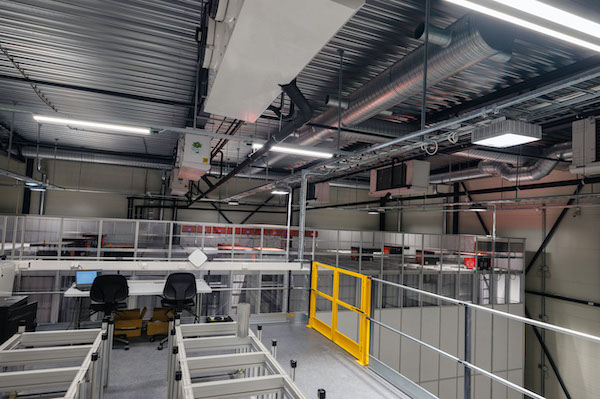Editor’s note: This is the first of two columns on the reinvention of Macy’s retail supply chain. In this one, we look at the department store leader’s focus on inventory productivity.
Can a 165-year-old department store chain evolve to meet today’s retail shopper and compete with fast fashion, off-price, and pure e-tailers? And, if so, what is the role of supply chain in that transformation?
Those are questions that Macy’s Inc., which had annual net sales of more than $24 billion in fiscal year 2022, began to answer before COVID-19. That’s when it launched the reinvention of the supply chain that largely supports the Macy’s brands.
One metric for the company is the “inventory productivity,” according to Dennis Mullahy, chief supply officer at Macy's. “If I can generate the same amount of sales with the least number of inventory receipts and fewer moves, I can maximize inventory productivity,” he said.
Macy's strategy demonstrates that supply chain innovation can have a positive impact on an organization’s bottom line. In its financial report for the fourth quarter of 2022, Adrian Mitchell, Macy’s chief financial officer and chief operating officer, noted that inventory declined 3% in comparison with 2021 and 18% from 2019. Likewise, inventory turnovers had improved over 2019.
“We made significant progress in leveraging data and analytics to better forecast sales demand, receipt timing, and flow across the supply chain,” Mitchell told analysts.
In addition to those supply chain management metrics, inventory productivity will continue to be a focus for Macy's. It plans to pursue this through initiatives such as improved automation and more flexible inventory allocation, both of which are designed to drive higher sell-throughs and more sales.
Macy’s supply chain reinvention supports the strategy of selling more with less, and at higher margins. It also enables the retailer to make good on its promise to “help our customers express their unique style and celebrate special moments both big and small, wherever and however they shop.” From Macy's perspective, the most important part of that phrase just may be “wherever and however they shop.”
The current approach also represents a departure from two conventional retail strategies: “Build it, and they will come, and then pile the inventory high to wow the customers with selection once you get them through the door.” And, “At the end of the season, you put it on sale to make room for the next delivery of new merchandise.”
Those strategies may have served the industry in the past, but that was then and this is now.
“Opening a new store and piling it high with inventory doesn’t work anymore because the consumer has more options,” Mullahy said. “There are more choices, more options in terms of digital and a lot of opportunities to buy.” He added that “from a supply chain perspective, we have to be more nimble and more strategic about investments, how we plan and how we think about consumer behavior.”
Macy's focuses on visibility, predictability, and flexibility
During a recent conversation, Mullahy touched on the three pillars that are guiding Macy’s supply chain transformation: Visibility, predictability, and flexibility. How do they play together?
Visibility is foundational. It’s one of those things that supply chains have been chasing as long as there have been supply chains. For Mullahy’s team, visibility is not just a matter of knowing where product is located as it moves from the manufacturer to the customer, but also real-time visibility into consumer demand across the various channels in which Macy’s participates. What is it that customers want right now, and where do they want it in relation to where that inventory is located?
Predictability is the art of mining through the data related to events that are occurring in the stores and online, and “then we are able to apply logic and math to predict what comes next,” Mullahy said. The goal is to manage inventory by moving it to where it’s needed, when there is demand.
“Retailers overbuy and put it in the stores because they’re unsure of demand,” he added. “We want to put our inventory into the best place to make a sale, maximize the flow of the unit through the building, and maximize the profit.”
A byproduct of getting visibility and predictability is that it minimizes the number of moves for inventory. Macy's is using a combination of commercial tools, such as those from companies like Blue Yonder, and tools that it has built internally.
The third building block is flexibility. As defined by Macy’s, it’s the ability to hold back some inventory in strategic locations until the supply chain team sees a demand signal and then move it where it can generate the most sales.
“The idea of flexibility is to be able to make decisions at each individual node and then determine the best path for our inventory,” Mullahy said. “In some cases, we decide upfront that we’re not sure where product will sell best, so when we import product in, we can break it out by a DC [distribution center] or by store and then consolidate and reconsolidate as required.”
Supply chain strategy helps weather challenges
One example of Macy’s supply chain visibility and flexibility is that it was one of the first retailers to diversify the ports it used. After the challenges of 2001, it reallocated about 20% of its imports to East Coast ports and away from California.
Flexible operations are able to react quickly to shifts in demand. In 2020, Macy’s transitioned from separate buildings for store replenishment and e-commerce fulfillment to omni-channel buildings that fill both types of orders from one shared inventory.
Within the buildings, Macy’s is investing in high levels of automation to drive speed and mitigate labor shortages. Two of the new automation tools include AutoStore robotic goods-to-person systems and pouch sorters. The systems are used for store replenishment and e-commerce fulfillment, depending on the size of the order.
“Both technologies allow us to pick directly into a bin or pouch that goes directly to a packer so we can move quickly,” said Mullahy.
Did the pandemic change Macy's strategy? On the contrary, Mullahy replied, the company's plans were already in place by the spring of 2020.
“We looked at COVID as a reason to accelerate strategies that we were already considering,” he said, crediting them with helping Macy’s get through the global shutdown and some of the pains associated with opening back up.
“We’ve worked very hard to build better planning tools [and] inventory management tools and to organize teams to make decisions quickly that leverage data and then communicate that across our operations,” Mullahy said.
In the next piece, we’ll look at the role sustainability plays in Macy’s supply chain.
About the Author
Follow Robotics 24/7 on Linkedin
Article topics
Email Sign Up

















